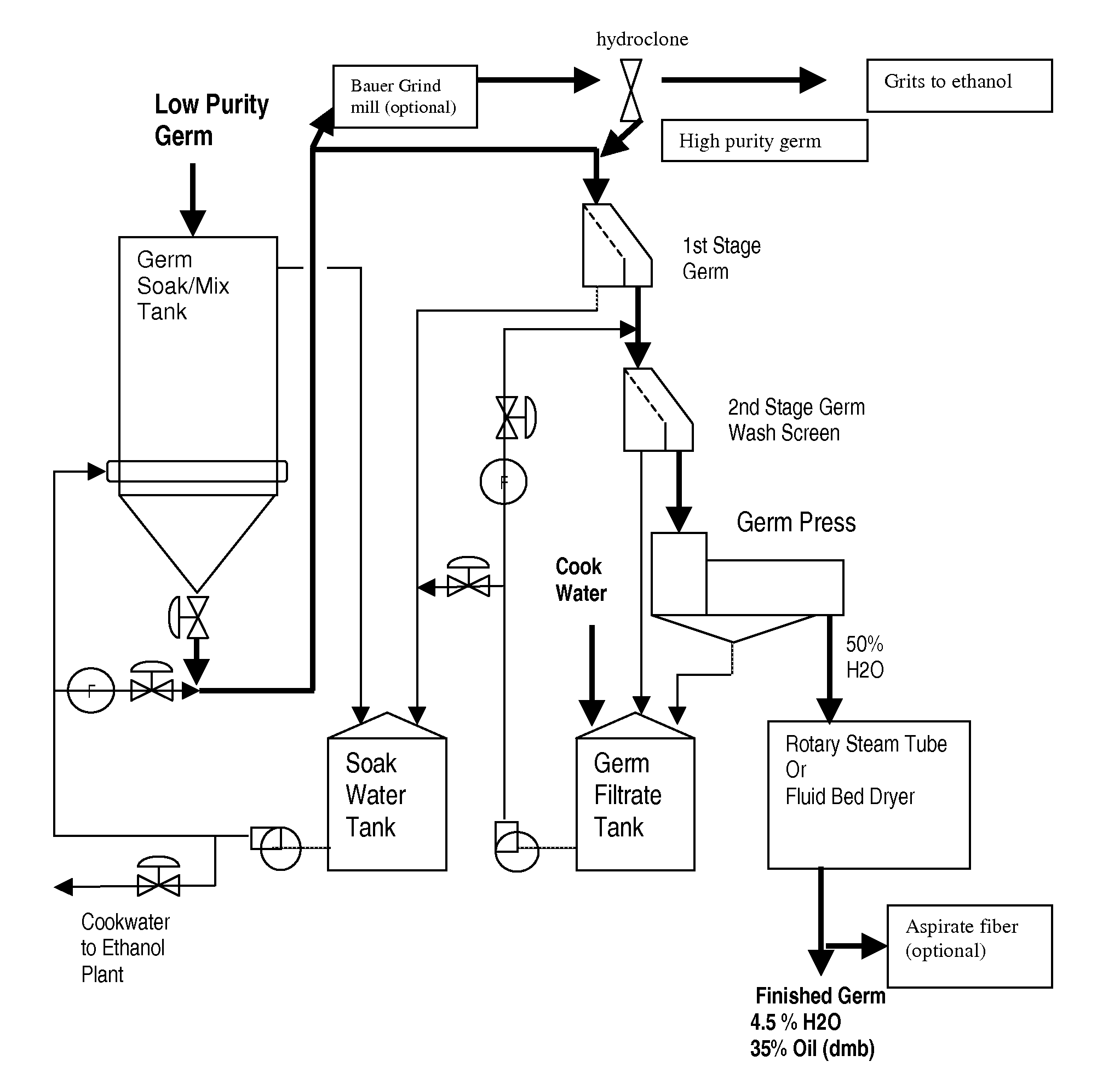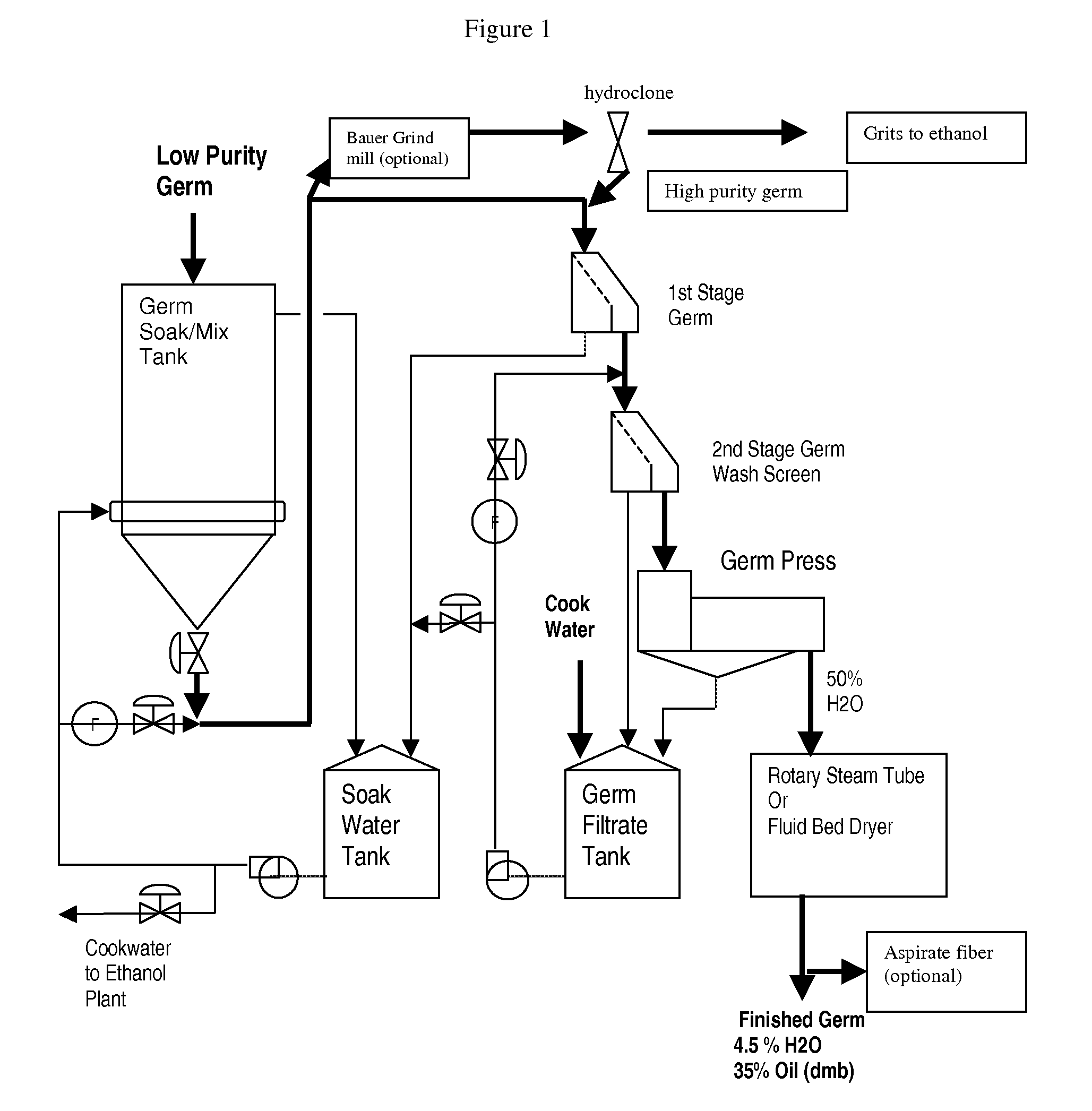Process for improving products of dry milling
a technology of dry milling and products, which is applied in the direction of biochemical equipment and processes, meat/fish preservation by drying, food preparation, etc., can solve the problems of high raw material cost and cost of bringing raw materials to plants, capital and labor costs are limitations on the economics of ethanol production, and reduce the quality of germ and pericarp, so as to reduce starch content and increase oil content. , the effect of increasing the oil conten
- Summary
- Abstract
- Description
- Claims
- Application Information
AI Technical Summary
Benefits of technology
Problems solved by technology
Method used
Image
Examples
example 1
[0047]In this experiment, commercially available, dry milled germ was utilized to determine the affect of time and water soak temperature on germ oil purity. A water bath was utilized to simulate soak temperatures germ may experience in the soak tank of FIG. 1. Temperature was monitored and adjusted prior to samples being placed. To demonstrate the soak process of the invention as displayed prior in the schematics, dry milled germ was placed in a flask and then filled with tap water and 0.1% alpha amylase and placed in the water bath. Temperatures evaluated included 155° F., 160° F., 165° F. and 170° F. Upon soaking for the allotted time, samples were removed from the bath and the soak water was drained and analyzed. Draining of the soak water in this experiment is similar to the first stage germ wash as described earlier for FIG. 1, whereby soak tank water is removed through screens and remaining material washed. After draining, fresh, clean water was added to the warm germ and giv...
example 2
[0051]Treatments (Table 8) for this experiment used commercially purchased dry milled germ having the properties set out in the table below.
TABLE 7Analysis of dry milled germ%Test (Eurofins)%dbMoisture9.660Protein, Kjeldhal13.4614.9Crude Fat14.5616.1Crude Fiber3.43.8Starch (CRA G-28)29.833.0PDI55.8na
Dry milled germ was soaked in tap water at the respective pH and soak period length to simulate various dry frac wet milling soak conditions. Alpha amylase was added to 60° C. treatments to understand its benefit in this new process. Total soluble protein (TSP) in the soak water was monitored by Bradford throughout the 8 hour soak experiments.
TABLE 8Soaking conditions that simulate and evaluate various dry fracwet milling conditions.pHtemp, C.time, hr0.01% enz3250.5—3252—3254—3258—3600.5—3602—3604—3608—6250.5—6252—6254—6258—6600.5—6602—6604—6608—6600.5y6602y6604y6608y9250.5—9252—9254—9258—9600.5—9602—9604—9608—
At the end of the soak period, a Bauer mill grind was simulated using an overh...
example 3
[0059]For this study, two hundred (200) pounds of dry milled germ were purchased. The germ for this trial was the same utilized in Example 2 above. A subsample of the starting material was analyzed with the results shown in Table 19. The oil and starch levels were similar to published values in terms of starch, oil, ash, sucrose and protein concentration. To maintain high PDI values, the corn that was dry milled for this study was allowed to dry down to less than 14% moisture in the field prior to harvesting. In turn, no artificial heat was necessary which could compromise or reduce PDI values.
TABLE 19Analytical results of the dry milled germ usedin Experiment 3 (%, dmb)%%Moisture, lab 110.2FructoseMoisture, lab 212.3GlucoseOil, acid hydrolysis26.1Sucrose10.7Oil, ether extract25.6MaltoseStarch, Ewers method19.5LactoseCrude protein20.1Ash7.7PDI57.7Phytic acid5.8Crude fiber4.6
Small, recirculating soak tanks having a 2 bushel (112 lb) capacity were used. Since RT water was used for soa...
PUM
| Property | Measurement | Unit |
|---|---|---|
| temperature | aaaaa | aaaaa |
| temperature | aaaaa | aaaaa |
| temperature | aaaaa | aaaaa |
Abstract
Description
Claims
Application Information
 Login to View More
Login to View More - R&D
- Intellectual Property
- Life Sciences
- Materials
- Tech Scout
- Unparalleled Data Quality
- Higher Quality Content
- 60% Fewer Hallucinations
Browse by: Latest US Patents, China's latest patents, Technical Efficacy Thesaurus, Application Domain, Technology Topic, Popular Technical Reports.
© 2025 PatSnap. All rights reserved.Legal|Privacy policy|Modern Slavery Act Transparency Statement|Sitemap|About US| Contact US: help@patsnap.com



